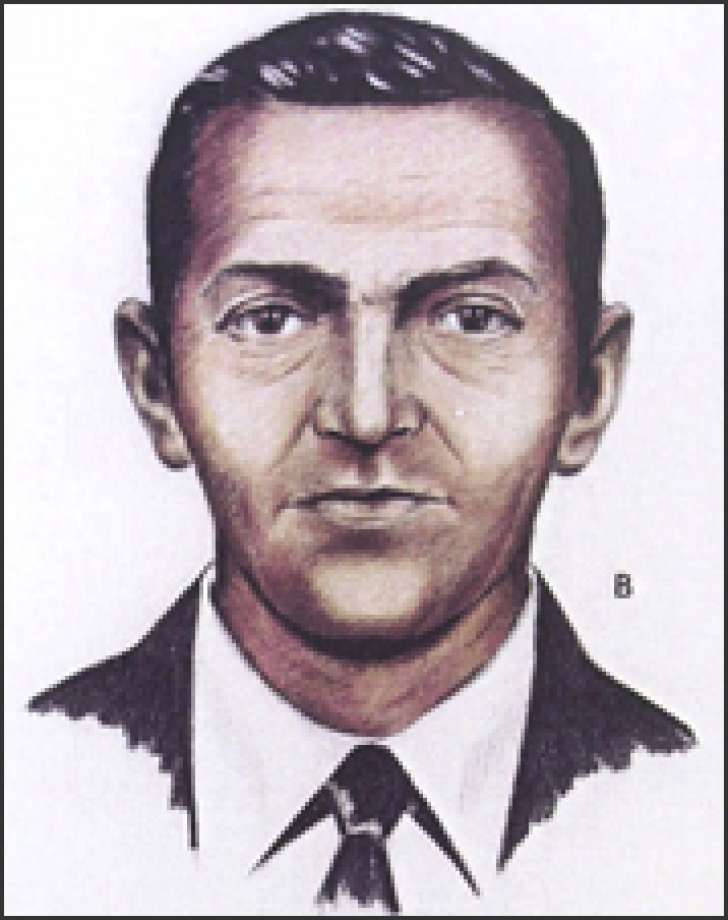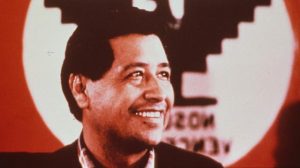Dan Cooper’s plane hijacking of November 24, 1971 is considered one of the greatest crimes to have ever been committed and has led investigators in a hunt for evidence for over forty-five years. It wasn’t until the summer of 2016 that investigators had had enough and closed the case. So, exactly what happened to made authorities get to this position?
On November 24, 1971, at the counter of Northwest Orient Airlines in Portland International Airport, a man who identified himself as Dan Cooper bought a one-way ticket on Flight 305 to Seattle, a thirty-minute flight. The man boarded the flight, which was a Boeing 727 aircraft, and took seat 18C and ordered a cup of bourbon and soda. He was described as a white-man who was in his forties, between 5’10 and 6 feet tall, and wore a black raincoat, with loafers, a dark suit, an ironed white-collared shirt, and a black tie.1 The flight took off at 2:50 p.m., with its fuel level at about one-third full.
Shortly after takeoff, Cooper slipped a note to one of the flight attendants, Florence Schaffner, who assumed that the note was Cooper’s phone number, or a love note, and she walked away. When she came back, Cooper flagged her down and told her “Miss, you’d better look at that note. I have a bomb.”2 The exact wording of the note is unknown because Cooper took the note back. After taking back the note, Cooper motioned for Schaffner to sit down beside him, where he then opened his briefcase and briefly showed eight red cylinders, “four on top of four.” After closing his briefcase, he dictated his demands: $200,000 “in negotiable American currency,” four parachutes (two primary, two reserves), and a fuel truck waiting for them upon landing.3 It is important to add that Cooper asked for the money to be only $20 bills. The attendant then went to the captain to give the demands and when she returned, Cooper had on his signature dark sunglasses.
Schaffner recalls that Cooper seemed familiar with the terrain that they were flying over. It was stated that he was able to point out the Tacoma river when they passed it.4 Cooper also mentioned that McChord Airforce Base was only a twenty-minute drive from the airport that they were heading to. The aircraft would then circle the airport for around two hours, so that they could allow the Seattle Police and FBI enough time to get the parachutes and the money that Cooper had demanded. Something that was surprising about all of this was how calm Cooper was throughout all of this. Schaffner described him as being “calm, polite, and well-spoken.”5 Another flight attendant claimed that “he wasn’t nervous, he was actually quite nice. He was never cruel or nasty. He was thoughtful and calm all the time….He ordered another bourbon and water, and offered to request meals for the crew once they arrived in Seattle.”6
At around 5:24, Cooper was told that his demands had been met and at 5:39, the plane landed. Cooper ordered the pilot to bring the plane to an isolated, brightly-lit section of the tarmac and for him to close all of the windows, so they could avoid police snipers. Once Cooper received his demands, he let go of all of the passengers, Schaffner, and another flight attendant off of the plane. The money that was given to Cooper all started their serial numbers with the letter L, so that when they were used, they could track the money easier.7
During refueling, Cooper told his plan to the crew in the cockpit. He wanted for them to take a course towards Mexico City at the minimum airspeed that they could go, without stalling the aircraft. The estimated speed would have to be around 100 knots, at the maximum altitude of 10,000 ft. He also specified that the landing gear remain in the takeoff/landing position, the wing flaps be lowered to 15 degrees, and the cabin remain unpressurized.8 The crew would then go on and argue that because of these flight conditions, they would need to refuel once again, this time in Reno, Nevada.
At around 7:40 p.m., the Boeing 727 took off with only five people on board.9 After takeoff, Cooper told the pilot and the rest of the crew to remain in the cockpit and stay there with the door closed. One of the flight attendants that remained on board noticed that Cooper was trying to tie something around his waist. At approximately 8:00 p.m., a warning light flashed in the cockpit, designating that the aft air stair had been activated. The crew would then offer assistance through the aircraft’s intercom system, but it was refused. The crew then noticed a major change in air pressure, indicating that the aft door was open.

At 8:13 p.m., the plane’s tail section sustained an upward movement, major enough to require them to reposition the aircraft back to level flight. It was at this moment that Dan Cooper made his infamous leap straight out of the plane. At around 10:15 p.m., the aft door was still deployed when the plane landed in Nevada for re-fueling. FBI agents, State Troopers, sheriff’s deputies, and the local police surrounded the plane, unaware that Cooper was no longer on board.10
Authorities later found 66 unidentified latent prints aboard the plane.11 Agents also found Cooper’s black clip-on tie, his tie clip, and two of the four parachutes. Local police and FBI agents then began questioning possible suspects. An Oregon man with the name of D.B. Cooper was one of the first to be questioned, because of his previous minor police record. The reason that he was contacted by Portland police was for the off-chance that the hijacker had used his name or an alias before. This Cooper was quickly ruled out as a suspect, but a local reporter named James Long, who had an impending deadline, confused the suspect’s name with the pseudonym used by the hijacker.12 It was because of this error that the name D.B. Cooper is now used with the hijacker.

A precise for Cooper was difficult for authorities to do, because of the small differences in the estimates of the plane’s speed, or the environmental conditions along the flight path. Another important variable is the length of time that Cooper was in the air before he pulled his ripcord if he even pulled it at all. None of the Air Force pilots who were trailing the aircraft saw anything leave the plane, neither did their radars, nor did they see a parachute open at all; but at night, with limited visibility, and a man dressed in black would be nearly impossible to see.
Initial searches guessed that Cooper landed somewhere within the area of Mt. St. Helena, a few miles away from Ariel, Washington, near Lake Merwin.13 Shortly after the spring of 1972, teams of FBI agents, with the help from nearly two-hundred army soldiers, conducted an eighteen-day land search, and another eighteen days the following month. These searches did not find anything relevant to the case; however, some local women did find some skeletal remains in an abandon shack. It was later proven to be the remains of a local female teenager who had been abducted and murdered a few weeks before. Ultimately, the search—probably the most extensive, and intensive in U.S. history—uncovered no real, significant evidence related to the hijacking.

It would seem that Cooper had completely erased himself and the money from the face of the earth. But nine years later, there was another break in the case. In February of 1980, a child named Brian Ingram found three of the packs of the ransom money at a beach front known as Tina Bar, outside Vancouver, Washington. The bills were terribly disfigured, but the serial numbers were matched to those that were given to Cooper nine years earlier.14 The ransom money remains the only physical evidence that was found outside of the aircraft to this date.
In 2011, the FBI discovered traces of pure titanium that was found on Cooper’s tie. They explained that traces of titanium would have been much rarer to find in the 1970’s, compared to today. At the time, it could only be discovered at metal fabrication or production facilities. These findings suggested that Cooper could have been a chemist or worked somewhere in a metal or chemical manufacturing plant.
On July 8, 2016, the FBI announced that it was suspending the case, stating that they needed to focus their energy on cases of higher priority, though they would still be open to finding evidence. This concluded the forty-five-year chase for Dan or D.B. Cooper, one of the greatest unsolved mysteries in American History.
- Tomas A. Tizon, “D.B. Cooper – the search for skyjacker missing since 1971,” San Francisco Chronicle (September 4, 2005). ↵
- Richard Steven, “When D.B. Cooper Dropped From Sky: Where did the daring, mysterious skyjacker go? Twenty-five years later, the search is still on for even a trace,” The Philadelphia Inquirer, (November 24, 1996). ↵
- Geoffrey Gray, “Unmasking D.B. Cooper,” New York Magazine, (October 21, 2007). ↵
- Lynn E. Bragg, Myths and Mysteries of Washington (Guilford, Connecticut: Globe Pequot, 2005), 2. ↵
- Richard Steven, “When D.B. Cooper Dropped From Sky: Where did the daring, mysterious skyjacker go? Twenty-five years later, the search is still on for even a trace,” The Philadelphia Inquirer, (November 24, 1996). ↵
- Tomas A. Tizon, “D.B. Cooper – the search for skyjacker missing since 1971,” San Francisco Chronicle (September 4, 2005). ↵
- “D.B. Cooper: Help Us Solve the Enduring Mystery“, FBI, (December 31, 2007). ↵
- Bryan Denson, “D.B. Cooper legend lives,” Oregon Live archive, (November 24, 1996). ↵
- “In Search of D.B. Cooper: New Developments in the Unsolved Case,” F.B.I. Headline Archives, (March 17, 2009). ↵
- “D.B. Cooper: Help Us Solve the Enduring Mystery,” FBI, (December 31, 2007). ↵
- Chris Ingalls, “Investigators: F.B.I. unveils new evidence in D.B. Cooper case,” (November 1, 2007). ↵
- W. Browning, “One mystery solved in ‘D.B. Cooper’ skyjacking fiasco,” Columbia Journalism Review, (July 22, 2016): 4. ↵
- David Rothenberg and Marta Ulvaeus, The New Earth Reader: The Best of Terra Nova (Cambridge, Massachusetts: MIT Press, 1999): 4. ↵
- M. Orzano, “D.B. Cooper skyjacking: 8-year-old Washington boy first to unearth ransom notes from 1971 incident,” Coinworld.com, (July 21, 2014). ↵



92 comments
Gabriela Ochoa
Really great article it was very descriptive. Before reading this article I knew some about Copper but not a lot.The story is really interesting to read about how one man could pull off such a significant heist. I thought that it was interesting that he was so calm during most situations the people committing the crime seem to be more anxious and jittery. This story makes people want to know how he got away with it and what actually happened to him and the money that wasn’t found.
Antoinette Johnson
Wow! I had never heard of this case of D.B Cooper, but I find it really intriguing because he hijacked a plane and remained calm and collected at the same time. I am glad no one was hurt in his process of taking the plane. It is baffling that he was never caught. It makes me think that maybe it was an inside job or he had a really well thought out pan on how he wanted to escape and receive the ransom. If I were in their shoes I would have been really terrified, but wonder why did D.B Cooper decide to hijack this particular. And why did he jump, I think maybe he suspected that the FBI would be waiting for him or someone on the inside let him know so that he can alter his plans to find another escape route.
Christopher Hohman
Great article. The story of D.B Cooper is one that I never heard before. It sure is mysterious how he just disappeared like that. I wonder if her survived the fall. It also makes me wonder just what was going through his head when he pulled this stunt. The flight attendants said he was perfectly calm and quite polite that is just straight up weird. They found some of his money too. That is really strange. To find it nine years after the event too that is really cool. It is like something they could make a movie about.
Dylan Coons
The legend of D.B Cooper is one of the most exciting tales in modern crime. Jumping out of a plane after robbing it? Who has the chutzpah to do something like that? Most criminals can hardly get away with robbing but this guy did it in a plane, jumped out, and then was never seen again. He knows how to do all of that, but can’t tie a tie. Honestly, the fact that he wore a clip-on tie is the most disappointing thing I’ve heard about this guy. Every time I’ve heard the story, I never remember hearing about his clip-on tie. Probably because it makes him sound really lame. Anyway, great article!
Sofia Andrade
I had never heard of this case before. While reading this article “the perfect crime came to mind”. To have this type of outcome there must have been extreme planning and timing. The knowledge he had of the terrain and the plane must have taken some time to research. The timing of the crime was also well planned for he jumped out of the plane when it was dark and he would go undetected.
Janelle Larios
It was very interesting reading this. I really love cases like this because you can come up with so many theories as to what had happened. I was really surprised that the FBI had suspended the case in 2016. It’s really weird to think that the FBI would be focused on a case like this for over forty-five years, when other relevant cases could have popped up in those forty-five years. It still irks me when cases turn out unsolved, I really wish in the end they did find him and that it doesn’t end up forgotten.
Lamont Traylor
The case of D.B. Cooper was very famous. I even saw a movie highlighting instances of his ordeal. Honestly, I admire him, not because of what he did, but the way that he went about it and how he was never found. As oddly as it sounds, I have always been fascinated by people that were smart enough to get away with their crimes, even serial killers.
Richard Morales
Before reading the article, I didn’t realize that I had seen this story before on television. Although I had already been exposed to the crime on television, it was nice to read a descriptive article using the narrative arc. I am currently working on one myself, and find this as a great example of what to do. My favorite part about this article is that it leaves you wondering. I feel, probably much like the FBI agents feel, that we know so much about a case and so little at the same time.
Hailey Rodriguez
Before reading this article, I had never heard of this crime, although the name “D.B. Cooper” does sound familiar never knew the meaning behind the name. It crazy to think that he was so pulled together and calm while speaking with the flight attendant and crew on the first plane. I also think that it is crazy that the FBI was never able to solve this case even 40 plus years later.
Maxx Arizmendi
I never heard of the DB Cooper hijacking case, so while reading this article I was immediately hooked on it. I was hoping there was going to be some drama and suspense while reading the article, and it did a great job showing what exactly went down during the hijacking. I found it hard to believe that it took them forty-five years to close the case, and to this day it still remains unsolved. This was a great article to read.